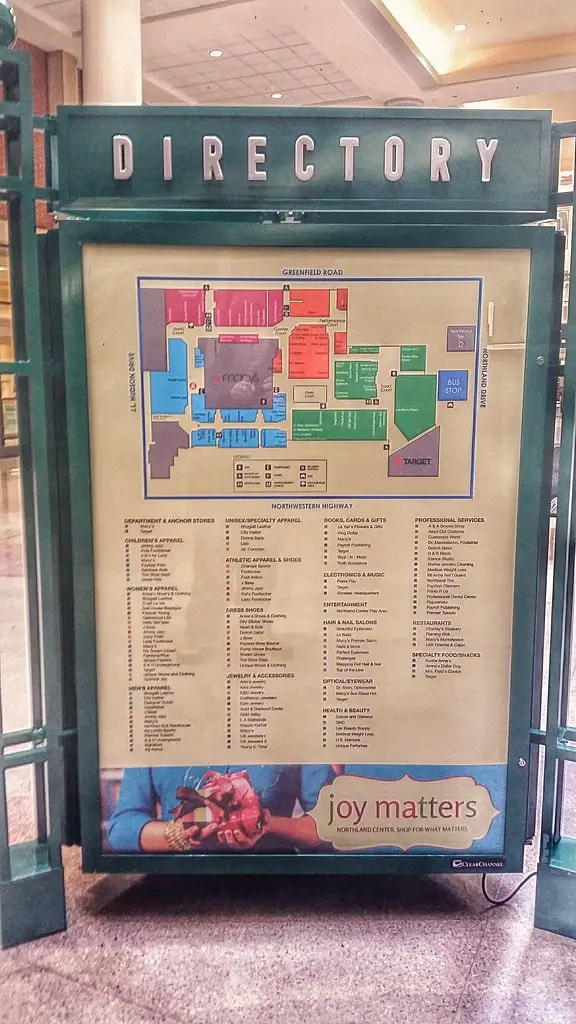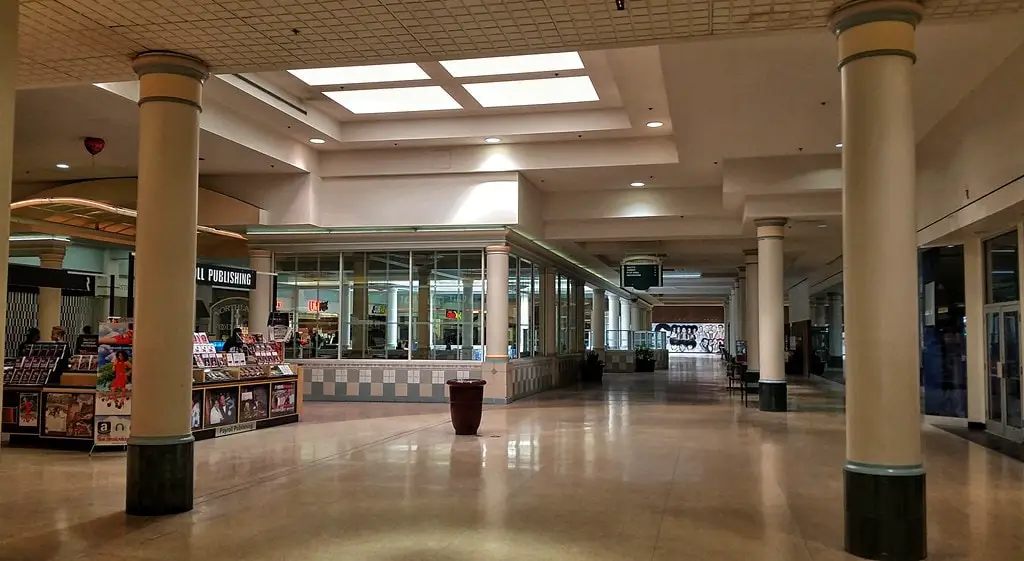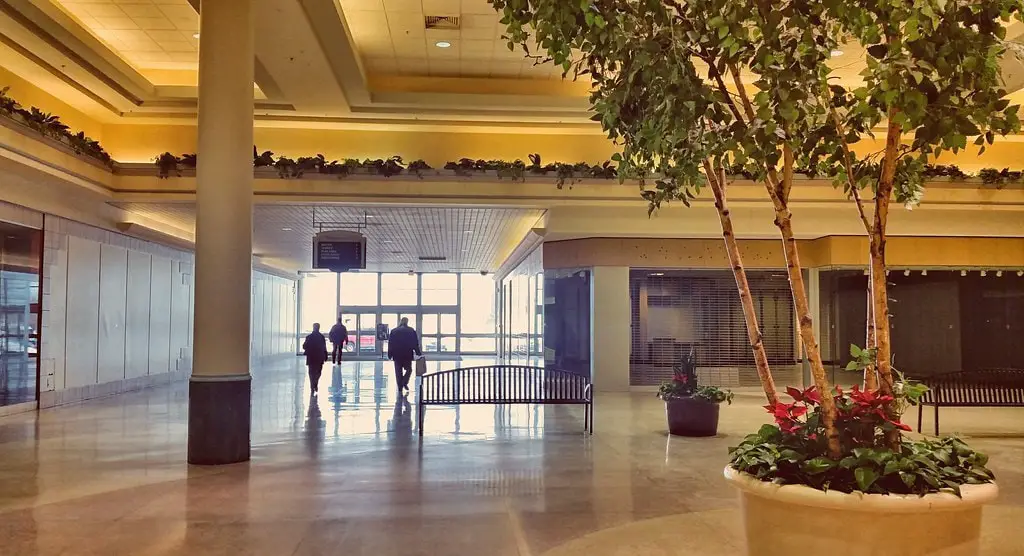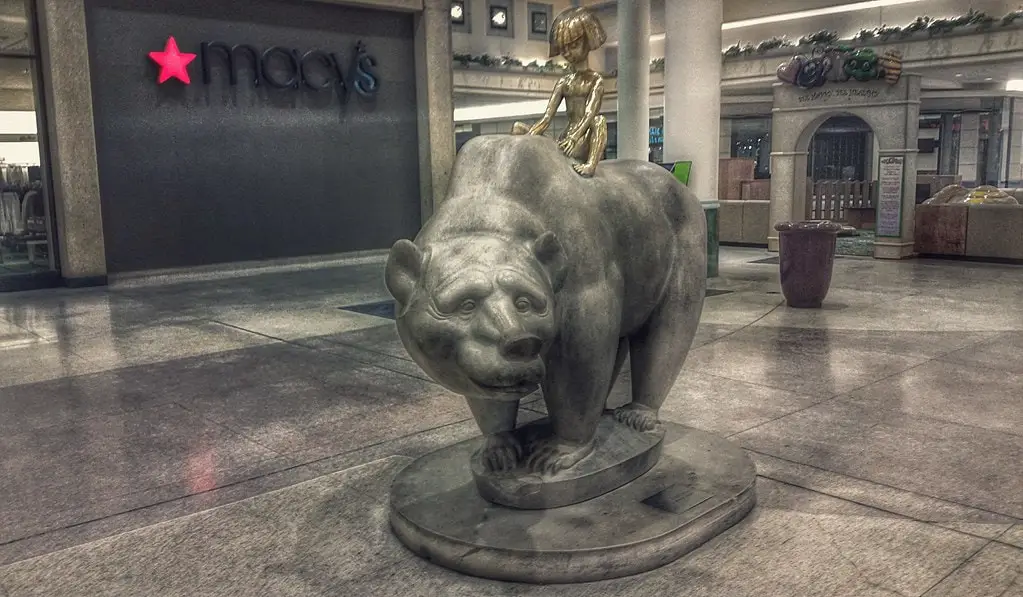The Birth of Northland Center Mall
Northland Center Mall, located in Southfield, Michigan, marked a significant milestone in American retail history when it opened its doors on March 22, 1954. This event was not just another mall opening but the unveiling of what would become a model for suburban shopping centers across the United States.
Developed by the J.L. Hudson Company, a Detroit-based department store chain, Northland Center was the brainchild of architect Victor Gruen. Gruen’s vision was to create a shopping environment that catered to the burgeoning suburban population, offering convenience and variety under one roof.
The mall’s initial structure was revolutionary for its time. Unlike the traditional downtown shopping districts, Northland was designed as an open-air complex featuring a four-level Hudson’s department store surrounded by smaller retail outlets.
This design provided shoppers with a centralized location to meet all their shopping needs. It included ample free parking, making it an attractive destination for the growing number of families moving to the suburbs.
Having a major department store anchor surrounded by smaller retailers was a novel idea that would set the standard for future shopping malls.
From its inception, Northland Center was more than just a place to shop; it was a community hub where people could gather, socialize, and enjoy a day out.
The mall featured an array of amenities, including auditoriums, a playhouse, and landscaped gardens, which added to its appeal as a family-friendly destination.
It was only a short time before Northland became a household name, drawing visitors from all over the Detroit metropolitan area and beyond.
The success of Northland Center paved the way for the development of similar shopping centers nationwide, forever changing the landscape of American retail.
The legacy of Northland Center continues to influence the Detroit area, contributing to the variety of things to do in Detroit.
Even after its closure, the site’s transformation into Northland City Center aims to maintain the community and innovation spirit of the original mall. This redevelopment reflects Detroit’s resilience and adaptability, offering new opportunities for socializing, shopping, and entertainment.
As Detroit evolves, the story of Northland Center serves as a reminder of the city’s rich history in shaping retail and community spaces.
Expansion and Evolution
The story of Northland Center is one of growth and transformation. After its initial success, the mall underwent several expansions and renovations to accommodate the increasing number of shoppers and retailers.
1975, a significant change occurred when the mall was enclosed, protecting visitors from the weather and enhancing the shopping experience. This year also marked the arrival of J.C. Penney, adding to the mall’s appeal as a shopping destination.
The evolution of Northland Center continued. The 1980s and 1990s saw further growth with the addition of new stores and services.
In 1985, MainStreet, a department store chain, opened its doors, only to be replaced by Kohl’s in 1989, reflecting the changing landscape of retail and consumer preferences.
The 1990s brought more variety by introducing popular stores like T.J. Maxx, Target, and Montgomery Ward, diversifying the shopping options available to customers.

These developments were not just about adding more space or stores; they were about adapting to the needs and wants of the community.
The mall’s ability to evolve with the times helped it maintain its status as a key shopping and social spot.
However, as the retail industry continued to change, so did the challenges Northland Center faced, setting the stage for the next phase in its history.
Major Retailers and Attractions
Northland Center had many stores and attractions that drew crowds for decades. The mall’s anchor stores, such as Hudson’s, later known as Macy’s, and J.C. Penney, were major draws.
These large department stores offered everything from clothing to household goods, making Northland a one-stop shop for many.
Beyond the anchor stores, Northland boasted various specialty shops and services. Retailers like Hughes & Hatcher, Max Green’s, and Baker’s Shoes offered shoppers multiple fashion options.
Meanwhile, stores like Cunningham Drug and S.S. Kresge Corporation catered to everyday needs, from prescriptions to household items.
The mall was not just about shopping; it was a place for entertainment and dining. The Northland Playhouse and various restaurants and food courts offered spaces for relaxation and socialization.
This combination of retail, service, and entertainment options made Northland Center a bustling hub for the community, offering something for everyone.

Decline and Closure
The decline of Northland Center began in the late 1990s and early 2000s, a period marked by significant changes in the retail industry and consumer habits.
The competition from newer shopping malls and the rise of online shopping started to impact Northland’s foot traffic and sales.
Key stores began to leave; Montgomery Ward closed in 1998 due to the company’s financial troubles, and J.C. Penney followed suit in 2000. T.J. Maxx closed its doors in 2004, reducing the mall’s appeal.
The early 2010s saw a continuation of this trend, with more stores leaving and visitor numbers dwindling.
In February 2015, Target closed its Northland location as part of a nationwide plan to shut down underperforming stores. This was a significant blow to the mall, as Target was one of its last major anchors.
The final nail in the coffin came when Macy’s, the last remaining anchor store, announced its closure in March 2015, 61 years after the mall opened.
With the departure of its anchor stores and a significant reduction in visitors, Northland Center could no longer sustain itself.
The mall officially closed its doors on April 15, 2015, marking the end of an era for Southfield and the surrounding community.
The closure reflected broader trends affecting malls across America. Still, it was felt deeply by those who had grown up with and worked at Northland.

The Tunnels Beneath Northland
Beneath the bustling shopping areas of Northland Center lay a hidden network of service tunnels, a lesser-known aspect of the mall’s infrastructure.
These underground passages, stretching several miles, were used for various purposes, including truck deliveries, storage, and workshop space.
At one point, they even housed a nuclear bomb shelter, reflecting the Cold War era during which the mall was constructed.
The tunnels were an integral part of Northland’s operations, allowing for the smooth handling of goods and services without disrupting the shopping experience above ground.
They contained 484 rooms and connected different mall parts, including the old power station, police substation, and the Firestone building.
This network was not unique to Northland but was one of the more extensive systems in American shopping centers.
Despite their practical use, the tunnels also held a certain mystique, with rumors and stories circulating among employees and visitors.
However, with the demolition of Northland Center in September 2021, the future of these tunnels became uncertain.
While some parts of the original structure, like the water tower and certain buildings, were preserved, it is likely that the tunnels were razed, erasing a fascinating piece of the mall’s history.

Redevelopment and Future Plans
After the closure of Northland Center in April 2015, the city of Southfield took a significant step by purchasing the property for $2.5 million in October 2015.
The aim was to clear the land for new development, signaling a new beginning for the area. The city had ambitious plans to transform the site into a vibrant, mixed-use space that could serve the community in new ways.
In July 2021, the city sold Northland Center to Contour Companies for $11 million. This sale began a new chapter for the former mall site.
Contour Companies announced plans for a $403 million redevelopment project, including large-scale housing and some retail spaces.
This project, known as Northland City Center, aimed to create a new community hub where people could live, work, and play.
The first phase of the redevelopment included the construction of over 1,500 new housing units, primarily in the form of five- and six-story buildings.
Additionally, 250 loft-style apartments were planned within the original structure of the mall, preserving a piece of its history.
The project also envisioned a food and goods emporium called Hudson City Market, which would feature a variety of food and entertainment options, home furnishing stores, and office space.
This ambitious plan aimed to breathe new life into the area, turning the site of the former mall into a dynamic part of Southfield’s future.

Transforming Northland: From Mall to Modern Living
The latest developments at the former Northland Center mark a significant shift from its historical use as a shopping center to a new residential and mixed-use space era.
The transformation is part of a larger trend in repurposing commercial real estate to meet contemporary needs and preferences.
In 2023, the redevelopment of the Northland Center site has progressed, with apartment buildings beginning to rise from the once-popular shopping mall’s ashes.
This project, led by Contour Companies, is set to become one of the largest multifamily complexes in Michigan. The redevelopment plan, known as Northland City Center, aims to create a vibrant community hub featuring live-work units, retail spaces, and recreational areas.
The vision for Northland City Center includes more than just residential units; it encompasses a new mixed-use development hub designed to foster a sense of community and provide a variety of amenities and services.
This approach reflects a broader shift towards creating spaces that blend living, working, and leisure in a single environment, catering to the evolving demands of modern urban life.
The transformation of the Northland site is a testament to the changing landscape of suburban Detroit and the adaptive reuse of former retail spaces. As the project continues, it promises to bring new life to the area, offering residents and visitors a place to live, work, and play.
New Business Hub Opens in Southfield, Michigan
A new Costco Business Center, the first of its kind in Michigan, opened in January 2024, transforming part of a former shopping mall into a specialized retail space.
This new center, over 160,000 square feet, is strategically located at a prime intersection, enhancing access for local businesses and consumers.
It represents the latest addition to the region’s retail offerings, focusing on the needs of companies in sectors like food service, convenience stores, and office management.
The center offers bulk quantities and an expanded selection of products tailored for business operations. However, individual consumers can also find items suitable for personal use.
Unlike traditional outlets, this location does not feature certain amenities like a bakery or pharmacy. It excludes categories such as alcohol and clothing.
It aims to streamline the shopping experience for business owners while providing next-day delivery services to the metro Detroit area, aligning with the company’s commitment to convenience and efficiency.

Legacy and Impact on Retail
Northland Center’s story reflects the broader trends in the retail industry and suburban development. As the first shopping mall of its kind, Northland set the standard for suburban shopping centers across the United States.
Its innovative design and role as a community hub made it a model for future developments. However, its decline and eventual closure also mirrored the challenges traditional malls face in the face of changing consumer behaviors and the rise of online shopping.
Despite its closure, Northland Center’s legacy lives on. It played a crucial role in shaping the concept of the American shopping mall. It influenced the design and development of similar centers nationwide.
The mall’s history reflects the economic and social changes that have shaped suburban America over the past several decades.
As the site undergoes redevelopment, the story of Northland Center continues to evolve. The transformation from a bustling shopping mall to a mixed-use development reflects the changing needs and preferences of the community.
While the retail landscape continues to change, the legacy of Northland Center serves as a reminder of the impact that innovative design and community-focused development can have on the retail industry and suburban life.

The “Bear” picture is Balloo the bear and Mogley the little boy from the story and movies of Jungle Book.
Thank you for your comment. Learning about the stories behind certain features of a place is always fun.